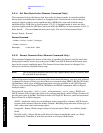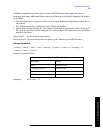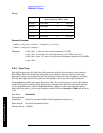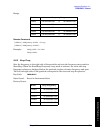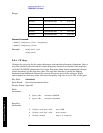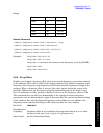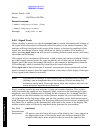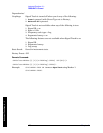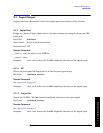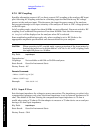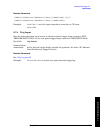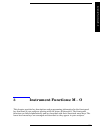
168 Chapter2
Instrument Functions: A - L
FREQUENCY / Channel
Instrument Functions: A - L
Factory Preset: 0 Hz
Range: –500 THz to 500 THz
Remote Command:
[:SENSe]:FREQuency:OFFSet <freq>
[:SENSe]:FREQuency:OFFSet?
Example: FREQ:OFFS 10 MHz
2.6.6 Signal Track
When a marker is placed on a signal and Signal Track is pressed, the marker will remain on
the signal while the analyzer retunes the center frequency to the marker frequency. The
analyzer will keep the signal at the center of the display, as long as the amplitude of the
signal does not change by more than 3 dB from one sweep to another. If no marker is
active, pressing Signal Track to On will activate a marker, perform a peak search, and center
the marker on the display.
If the signal is lost, an attempt will be made to find it again and continue tracking. If there
are other signals on screen near the same amplitude, one of them may be found instead.
Signals near 0 Hz cannot be tracked effectively as they cannot be distinguished from the
LO feedthrough, which is excluded by intent from the search algorithm.
When
Signal Track is On and the span is reduced, an automatic zoom is performed and the
span is reduced in steps so that the signal remains at the center of the display. If the span
is zero, signal track cannot be activated.
NOTE This function is intended to track signals with a frequency that is changing
(drifting), and an amplitude that is not changing. It keeps tracking if in
continuous-sweep mode. If in single-sweep mode, the analyzer only does one
center frequency adjustment as necessary.
Signaltrackingcanalsobeusedwiththe∆ (delta) pair marker function. This could be
used to measure the amplitude at a frequency offset, relative to the fundamental signal
amplitude, even if the fundamental is drifting. In this situation, the “tracking” function
will be done on the delta marker, not on the reference marker. So you would want to put
the ref marker on the frequency+offset, and put the ∆ marker on the fundamental signal
peak. Then turn on signal tracking. The frequency difference between the two markers will
stay fixed. The ∆ marker, on the fundamental, will track to the center of the display. The
marker readout value will show the amplitude delta between the two markers.
Key Path: FREQUENCY
Annunciation/
Annotation: ST appears near the lower-left corner of the display. An (*) may appear in
the upper-right corner of the display while the analyzer whenever the
analyzer finds that it must retune in order to center the signal on the



